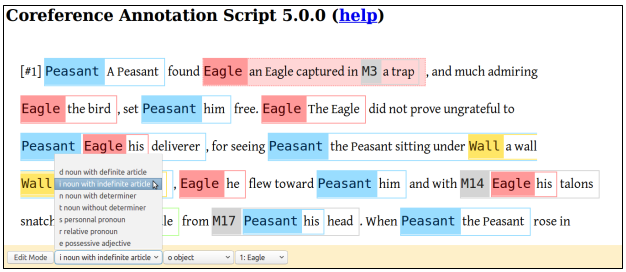Coreference annotation tool (SACR)
SACR (from the French "Script d'Annotation des Chaînes de Référence") is a tool optimized for coreference chain annotation.
It has been published in the following paper:
Oberle B. (2018). SACR: A Drag-and-Drop Based Tool for Coreference Annotation. Proceedings of the 11th Edition of the Language Resources and Evaluation Conference (LREC 2018). Miyazaki, Japan (poster)
use it now! download code view github repo see the user guide watch tutorials (YouTube)
On this page:
Workflow
SACR is a single webpage. All operations are done in the browser. You can download the code and open the index.html file, or use it online (see links above).
The workflow is as follows:
(1) Mark the referring expressions:
(2) Build the coreference chains:
(3) Add feature annotations:
(4) Play and search:
Getting help
Documentation can be found in the user_guide.pdf file. It is a work in progress, with some English sections to be done. It has not yet been proof-read.
I have made some video tutorials in French, available on YouTube (see also the playlist) (these links open in new window or tab):
- 01: ouvrir un fichier
- 02: annoter
- 03: stratégies d'annotation
- 04: sauver les annotations
- 05: la popup
- 06: naviguer
- 07: annoter les propriétés de chaque mention
- 08: rechercher
- 09 configurer
- 10: récapitulatif
- 11: comment afficher la popup bloquée par Firefox?
Convert all the annotation into a relational database
Use the coreference database project scripts to convert your work into a relational database, in the form of a series of CSV (Comma Separated Values) files, that you can use in a spreadsheet program like Microsoft Office or LibreOffice Calc, or in a specialized statistic program like R or Python's Pandas.
This works for a single text or a whole corpus (several texts separately annotated with SACR).
The table (CSV files) are:
tokens: all the tokens in the textssentences: all the sentences in the texts, with specific annotations (like the number of tokens, mentions, chains, etc.),paragraphs: all the paragraphs in the texts, with specific annotations (like the number of tokens, mentions, chains, etc.),texts: all the texts, with specific annotations (like the number of tokens, mentions, chains, etc.),chains: all the chains in the texts, with specific annotations (like the number of mentions, etc.)mentions: all the mentions in the texts, with specific annotations (like the name of the chain, the size of the chain, etc.)relations: all the relations in the texts, with specific annotations (like the distance between two mentions). There are several types of relations:first: relations from the first mention to every other mentions in the chain (A-B, A-C, A-D...),consecutive: relations from a mention to the next mention in the chain (A-B, B-C, C-D...),all: both first and consecutive relations.
Note that there is simpler beta version available online here.
Conversion scripts to other formats
From other coreference formats
See the corefconversion project to convert to and from Conll and other formats.
From and To Glozz and TXM
You can convert between formats online (offline while updating the new website):
You can also download the following Perl scripts to perform the conversion on your own computer:
sacr2glozzglozz2sacr- ExportToGlozz (a groovy macro to export a TXM corpus to Glozz)
To export and import to TXM:
- export the
.sacrfile from SACR - make a directory called
CORPUS_NAME - run
perl sacr2glozz<VERSION>.pl -K --model --link-name MENTION -p REF FILE.sacr CORPUS_NAME/export - you will then find in the
CORPUS_NAMEdirectory three files (aam,ac,aa) - if you add the options
-m 2 -e SI, singletons will have "SI" as referent name - open TXM and import the Glozz corpus




